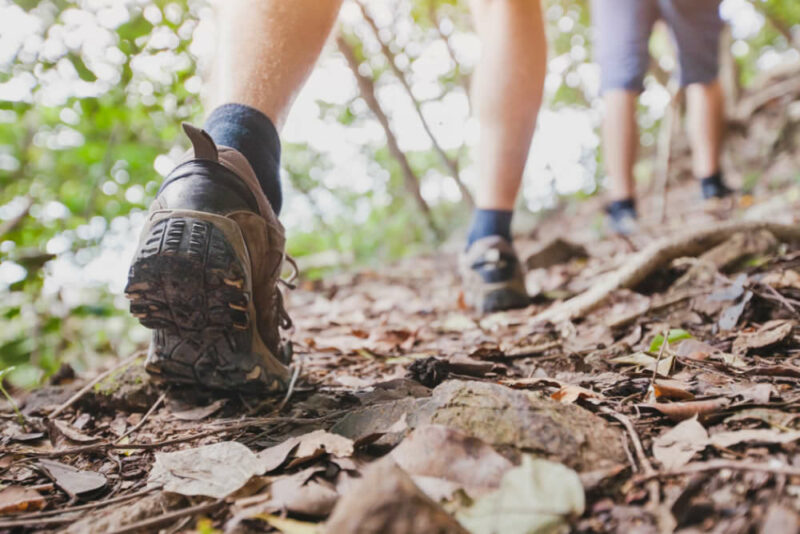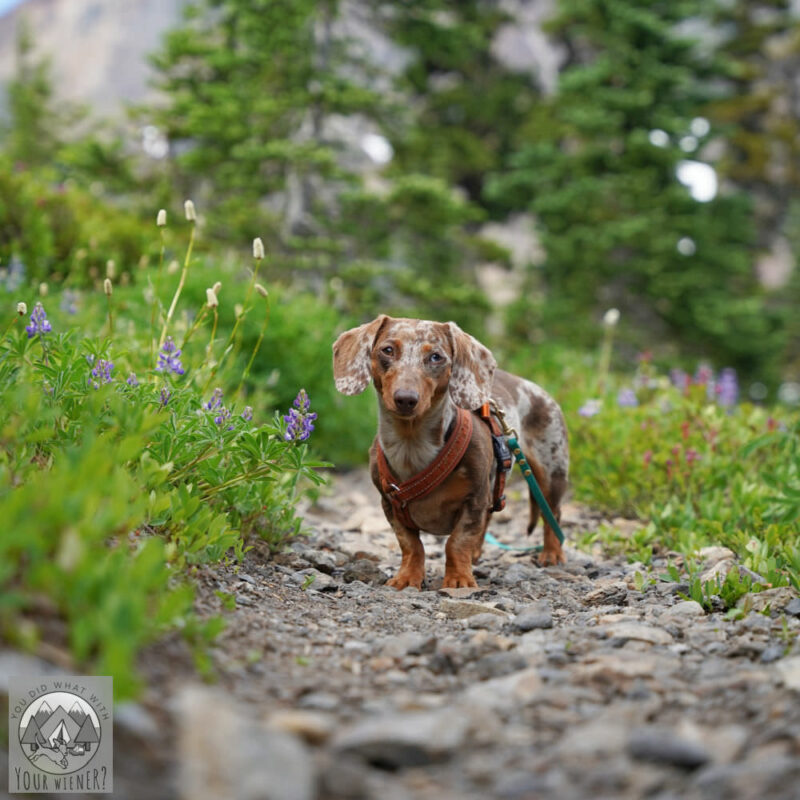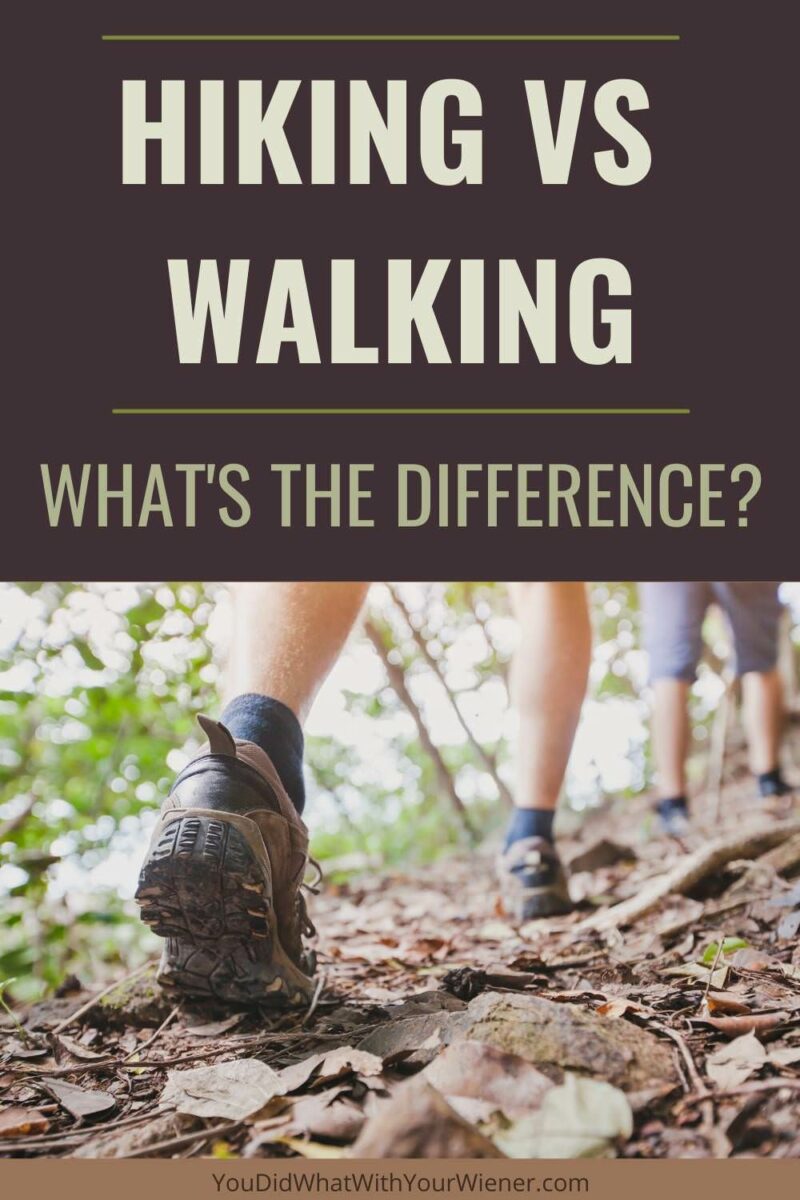What Does Hiking Mean? How Is It Different Than Walking?
If you’ve found my article, you’re probably wondering “What is hiking?” or “What is the definition of hiking?”
When someone says they’re going for a hike, what exactly do they mean? How is hiking different than walking?
When I started this blog, I had been hiking for almost 15 years. I was sure I knew what hiking meant.
Note: This article was originally published in January 2014

In hindsight, I had a very narrow definition of what hiking was. It was maybe even a little elitist.
Through this blog I’ve realized that hiking can mean different things to different people (and can differ by geographical region).
Since I see people asking “What counts as a hike?” or “What defines a hike?” a lot, I thought I would take a moment to share both the general definition of hiking and how I determine if I’m hiking vs walking.
What Is Hiking?
When I think of hiking, I envision walking off pavement on a surface like dirt, sand, or rocks.
I also envision the path has some elevation gain, either undulating up and down or rising steadily until I reach a specific destination.
I also envision an activity that is longer – both in duration and distance.
I joined the 52 hike challenge last year and, for the purpose of counting toward the challenge goal, they definite a hike as anything over 1 mile.
For beginners and people just starting out, this may be an appropriate distance.
However, for the more experienced, a hike is typically a lot longer than that.
Personally, I generally consider anything under 3 miles to be a walk.
If it’s under 3 miles, at my pace, I’ve barely been outside for an hour. I also don’t feel like it’s sufficiently raised my heart rate.
One great thing about hiking is that you get to define what hiking means to you.
While there are some commonalities, a one person’s definition of a hike may be different than someone else’s
My personal definition of hiking includes:
- It’s in nature and on a dirt of gravel surface
- It has an elevation gain/loss of at least 200 feet per mile and/or is a “long distance” hike of over 3 miles
- It elevates my heart rate, and implies more work, that simple walking (ie. it’s not easy to carry on a full conversation when walking uphill)
- It requires the use of hiking boots and wicking, quick-dry clothing (because it probably involves some sweat)
- It has a natural feature as a destination – waterfall, lake, peak, abandoned mining camp, etc.
What’s the Difference Between Hiking and Walking?
People often wonder how hiking is different than walking.
Some definitions of walking are:
- To move at a regular pace by lifting and setting down each foot in turn, never having both feet off the ground at once
- To move along by putting one foot in front of the other, allowing each foot to touch the ground before lifting the next
- To move about or travel on foot for exercise or pleasure
Technically, hiking meets these definitions too – putting one foot in front of the other to travel overland for exercise or pleasure.
Also, the criteria I discussed in the section above – being on a natural surface, gaining elevation, and going for more at least 3 miles – are things that can be achieved by someone who simply went for a walk too.
Given these things, I completely understand how drawing a line between walking and hiking can be difficult and confusing.

So what is the difference between hiking and walking?
Really, hiking is just walking but done is a slightly different way with different clothing and gear (more on this later).
Some things that make a hike different from a walk include:
- Walking is typically done in an urban environment where the path is partially or fully paved or on a well-worn constructed path
- Hiking typically requires more effort than walking because the terrain on hiking trails is more challenging
- One needs to carry more supplies when out on a hike because of the duration and increased risk involved
As a more “formal” definition of hiking, Wikipedia says this:
“[Hiking is] a form of walking, undertaken with the specific purpose of exploring and enjoying the scenery. It usually takes place on trails in rural or wilderness areas.”
Benefits of Hiking vs Walking
Walking and hiking are both low-impact cardiovascular exercises.
They share some similar health benefits:
- They can help improve your cardiovascular system, lungs, and heart
- They can help you manage blood pressure and cholesterol levels
- They can help you manage blood sugar, glucose tolerance, and Type II Diabetes
- They can help you lose weight
Hiking is like walking on steroids. Everything is amped up, including the benefits.
There are several additional benefits to hiking vs walking though.
Hiking benefits include:
- You burn more calories hiking
- Hiking can help tone and strengthen your leg and core muscles
- You get more fresh air hiking (because you are away from city smog and you are typically out for a longer duration)
- Hiking can help you feel more connected to nature
- Hiking can be a form of active meditation that clears your mind (one is more likely to get in “the zone” when hiking)
How many calories can you burn hiking?
Since a lot of people nowadays take up hiking for fitness and weight loss, I’m including this information.
Hiking definitely burns more calories than walking but how many more depends on several variables like your weight, gender, duration of the hike, terrain, and how much weight you’re carrying in your backpack.
While you can burn around 100-200 calories per hour walking, you can easily double that figure when hiking.
If you carry a heavy pack, and the terrain is steep, you can burn over 500 calories per hour!
For example, I currently weight 180 lbs and carry a backpack that weighs 10-15 lbs.
My typical hike distance is 5 miles round trip and includse both up and down (either all uphill to the destination then al down or over rolling terrain).
On an average hike, I burn approximately 530 calories per hour.
If I was walking, even if I was walking at a fast pace (faster than I normally hike), I would only burn around 360 calories per hour.
If you want to figure out how many calories you would burn per hour hiking, use this calculator.

Extra Gear You’ll Need For A Walk vs A Hike With Your Dog
When you go for a walk, you often don’t need more than shoes and a jacket for you and a leash, harness, and poop bags for your dog.
You’ll need to take more with you when you hike.
You’ll need sturdier shoes for hiking
When you’re hiking, you will be moving over rougher terrain, often with lose rock and dirt, and sometimes with obstacles you need to navigate around.
That means you will need different shoes.
The primary differences between hiking and walking shoes is that hiking shoes or boots provide more support for your feet and ankles and the sole tread provides better traction.
You’ll need to bring layers of clothing
You will be out for longer than you would for a walk.
The average hiker, depending on the steepness of the terrain, hikes 1.5-2 miles per hour.
That means you can expect to be out for approximately 3 hours for a 6-mile hike, not including breaks.
The longer you’re out, especially in the mountains, there more likely it is that the weather could change significantly from when you started.
That means you need to bring clothes for you and your dog that you can layer so you can add more if warmth is needed and peel off layers if you’re too hot.
You’ll need to bring food, snacks, and water
When you go for a walk, you usually plan to return home before you get hungry or thirsty.
Even if you bring some water to keep you and your dog hydrated, it’s typically a small amount.
When you are out longer, you will need to plan for meals and snack breaks in order to maintain your energy and stay in good spirits (not become hangry).
You and your dog will also need more water since you will be exerting more physical effort and losing water through perspiration and respiration.
You’ll need to carry gear and supplies with you
When I take my dogs for a hike, these are the items, at a minimum, I bring with us:
- Backpack to carry everything
- Enough water for me and my dog
- Collapsible water dish for my dog
- Food and treats
- Leash and harness
- Poop bags
- An additional wool shirt
- Extra wool socks (in case mine get soaked and can double as gloves in an emergency)
- Rain jacket (optional, depending on weather forecast)
- Dog jacket (and extra light layer if they’re already wearing one on the hike)
- Small first aid kit that includes dog-specific items
- Headlamp
- Map (downloaded digital like from Alltrails)
- Sunblock and/or big spray, depending on the season
- camera (optional)
- Garmin InReach Satellite Messenger and SOS beacon (optional)
- Hiking poles (optional)
For a more detailed list, check my other article: What I Bring When Hiking With My Dog
If you’re just starting out, don’t make these beginner mistakes when hiking with your dog.
Also check out my hiking with dogs etiquette tips.
Conclusion
Hiking isn’t all that different than walking in many respects.
However, there are significant differences.
Hiking can burn more calories and offer health benefits above and beyond what walking can – both physical and mental.
With the additional challenges of hiking, including being out in the elements longer and often further away from urban areas, there comes a need to be more prepared though.
If you are going to hike, with or without your dog, make sure you bring the minimal essential supplies to be comfortable and handle little emergencies.


About the Author
Hi, I’m Jessica. I’ve been studying the Dachshund breed since 2007, owned 3 of my own, and shared in the lives of thousands of others through their owner’s stories. When I’m not sharing what I know on this blog, you can find me hiking, camping, and traveling with my adventurous wiener dogs.

I would say all those qualify as hikes. For me, if it involves taking water for everyone because we will be gone a long time, that counts. And lunch LOL
Yes, that does count 🙂 Even though I bring a lot of water, I forget to drink as much as I should. I am better about making sure Chester and Gretel get theirs….and my hubby because he gets grumpy if not 🙂
I agree with your definition!
Generally I’d consider hiking anything that’s not on a paved path, not in an urban centre, and that either (a) involves elevation gain; (b) is longer or more strenuous than your average walk; or (c) is both.
But I think I like the thought you’ve put into it better!
My definition is very much the same of yours with a little extra thrown in 🙂
Um, well, you’ve thought about this a lot more than I have…
I think your definition is perfect. We also love to hike.
The definition is very good 🙂
I love hiking, although nowadays I am not able to do it as much as I would like. But one of my fondest memories as a child was hiking through the woods with our parents? And we had loads of fun!!!
((Husky hugz))
“Love is being owned by a husky”
I can’t hike as much as I used to either. Being an “adult” means more things I have to get done and less freedom but I also struggle with lower back pain. I have to be really careful to stretch after but even then I sometimes can’t hike two days in a row. We do what we can right?
We loosely say we went for a hike meaning a longer walk, but our true feeling is that a hike is in the wilderness, mountain, prairie, or somewhere off road with trails that are rugged. Going up a mountain is a definite hike, but here in MN, we don’t have any of those, so for us, it is hiking trails through the woods often with inclines, some water, just out in nature. Hiking boots may not be necessary, but no flip flops or “girly” shoes, you need good shoes for the rugged terrain. It should also be at least an hour hike and you should sweat and feel like you did something when you are done. We like this post as Mom often wonders why some people call their walks hikes.
I’ve hiked plenty of trails that didn’t go up a mountain but was very undulating with A LOT of elevation gain and loss over the length (even though the absolute elevation gain was not that much). If I had to pick ONE differentiation for me, it would be the sweating that you mention 🙂 I’be sometimes sweatted on a walk but never NOT sweatted on a “real” hike.
I pretty much agree with you! Like I said its nothing for us to do 5 miles a day but its not a hike. Probably even our walks in the forest preserve aren’t but we are looking forward to living vicariously through yours! Love Dolly
We’ll we’re happy to have you “vicariously” along for the adventure 🙂
What a super fun idea. Good luck with meeting your goal. Hiking for us is wandering around the neighborhood. That’s just how we roll. Before Mom’s knee surgery, hiking was anything that involved getting off the couch. Now that her knee is new, we’re off the couch for good!
Love and licks,
Cupcake
My definition of hiking definitely requires it to be more strenuous than a “normal” walk. Elevation, to be sure, and a certain rugged quality of wilderness.
Hmm… I think the most important factors for what we consider “hiking” are the first two you mentioned: a true nature trail that is somewhat challenging in nature, and not too short, either. The destination is a bonus!
I’m searching for a great hiking backpack that will hold my dog and gear for a day trip. What do you have? Your pack in the picture looks pretty sweet!
Hi Alynn. I don’t use a pack to carry my dogs on a regular basis. I do carry a little, flimsy one to use in the case of emergencies (we’ve only used it twice in 10 years). It’s not super comfortable or the dog. In face. I would advise against using it regularly for a Doxie because of their fragile backs. Perhaps that is the photo you saw…the one of me carrying Chester in a front pack?
I get a lot of questions about backpacks to carry dogs…especially Dachshunds. Chester is 12 now and slowing down. There will come a day when he can no longer keep up with our hikes. I have been on the lookout for a backpack to carry him so we are prepared when that day comes. I haven’t found anything yet.
I have seen a couple that would work for other types of small dogs. What kind of dog do you have?
the name is the best thing going
Thank you